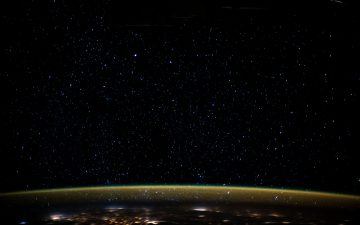Katie Mack in aeon:
 Space, as they say, is big. In The Hitchhiker’s Guide to the Galaxy (1979), Douglas Adams elaborates: ‘You may think it’s a long way down the road to the chemist, but that’s just peanuts to space.’ It’s hard to convey in everyday terms the enormity of the cosmos when most of us have trouble even visualising the size of the Earth, much less the galaxy, or the vast expanses of intergalactic space. We often talk in terms of light-years – the distance light can travel in a year – as though the speed of light is somehow more intuitive than a number written in the trillions of kilometres. We give benchmarks in the same terms (it takes light 1.3 seconds to travel between the Earth and the Moon) but, in our everyday experience, light is instantaneous. We might as well talk about the height of a building in terms of stacking up atoms.
Space, as they say, is big. In The Hitchhiker’s Guide to the Galaxy (1979), Douglas Adams elaborates: ‘You may think it’s a long way down the road to the chemist, but that’s just peanuts to space.’ It’s hard to convey in everyday terms the enormity of the cosmos when most of us have trouble even visualising the size of the Earth, much less the galaxy, or the vast expanses of intergalactic space. We often talk in terms of light-years – the distance light can travel in a year – as though the speed of light is somehow more intuitive than a number written in the trillions of kilometres. We give benchmarks in the same terms (it takes light 1.3 seconds to travel between the Earth and the Moon) but, in our everyday experience, light is instantaneous. We might as well talk about the height of a building in terms of stacking up atoms.
Maybe, if we’re feeling more adventurous, we use analogies based on personal experience. The distance to the Moon is 32 million school buses! If you could drive there in one of those school buses, going at 60 miles per hour, it would take you 166 days! I’m not sure that helps.
I wish I could say that astronomers have a better intuitive grasp of all this. We don’t. Brains don’t really work that way. So we cheat with numbers. We use longer yardsticks to talk about bigger spaces: kilometres, light-years, parsecs, kiloparsecs, megaparsecs, gigaparsecs. We get comfortable with exponents (1,000 is 103; 1 trillion is 1012) and think in logarithmic intervals, where each successive step is a new power of 10. At some point, distance stops being a straightforward concept entirely. Here in the Solar System, space and time are both more or less well-behaved, but when you have to deal with the cosmos as a whole, you have to factor in the fact that it refuses to sit still for its fitting.
Space is expanding. It has been since the Big Bang, and it’s not stopping any time soon. If you look at a galaxy far, far away, not only do you have to factor in that the image you’re looking at is old, you have to account for the fact that it’s no longer where it was when you saw it. Let’s say you see a supernova go off, in a galaxy a billion light-years away. Did the supernova just go off, or did it go off a billion years ago? You can say the latter, because the light has been travelling to us for a billion years, but since there was no way to observe it back then, what does saying that it went off in the past even mean? And that billion-light-year-distant galaxy – how far away is it, really? Maybe a billion years ago it was a billion light-years away, but the Universe has been expanding all that time, so now it must be much farther. Which distance do we use?
More here.
